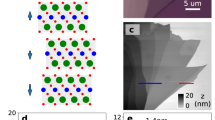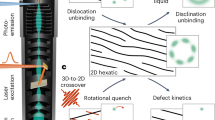Abstract
Layer-by-layer material engineering has produced interesting quantum phenomena such as interfacial superconductivity and the quantum anomalous Hall effect. However, probing electronic states layer by layer remains challenging. This is exemplified by the difficulty in understanding the layer origins of topological electronic states in magnetic topological insulators. Here we report a layer-encoded frequency-domain photoemission experiment on the magnetic topological insulator (MnBi2Te4)(Bi2Te3) that characterizes the origins of its electronic states. Infrared laser excitations launch coherent lattice vibrations with the layer index encoded by the vibration frequency. Photoemission spectroscopy then tracks the electron dynamics, where the layer information is carried in the frequency domain. This layer–frequency correspondence shows wavefunction relocation of the topological surface state from the top magnetic layer into the buried second layer, reconciling the controversy over the vanishing broken-symmetry energy gap in (MnBi2Te4)(Bi2Te3) and its related compounds. The layer–frequency correspondence can be harnessed to disentangle electronic states layer by layer in a broad class of van der Waals superlattices.
This is a preview of subscription content, access via your institution
Access options
Access Nature and 54 other Nature Portfolio journals
Get Nature+, our best-value online-access subscription
$29.99 / 30 days
cancel any time
Subscribe to this journal
Receive 12 print issues and online access
$209.00 per year
only $17.42 per issue
Buy this article
- Purchase on Springer Link
- Instant access to full article PDF
Prices may be subject to local taxes which are calculated during checkout




Similar content being viewed by others
Data availability
Source data are provided with this paper. All other data that support the plots and other findings of this study are available from the corresponding authors upon reasonable request.
References
Liu, C. et al. Robust axion insulator and Chern insulator phases in a two-dimensional antiferromagnetic topological insulator. Nat. Mater. 19, 522–527 (2020).
Deng, Y. et al. Quantum anomalous Hall effect in intrinsic magnetic topological insulator MnBi2Te4. Science 367, 895–900 (2020).
Klimovskikh, I. I. et al. Tunable 3D/2D magnetism in the (MnBi2Te4)(Bi2Te3)m topological insulators family. npj Quantum Mater. 5, 54 (2020).
Hao, Y.-J. et al. Gapless surface Dirac cone in antiferromagnetic topological insulator MnBi2Te4. Phys. Rev. X 9, 041038 (2019).
Chen, Y. J. et al. Topological electronic structure and its temperature evolution in antiferromagnetic topological insulator MnBi2Te4. Phys. Rev. X 9, 041040 (2019).
Nevola, D. et al. Coexistence of surface ferromagnetism and a gapless topological state in MnBi2Te4. Phys. Rev. Lett. 125, 117205 (2020).
Otrokov, M. M. et al. Prediction and observation of an antiferromagnetic topological insulator. Nature 576, 416–422 (2019).
Shikin, A. M. et al. Sample-dependent Dirac-point gap in MnBi2Te4 and its response to applied surface charge: a combined photoemission and ab initio study. Phys. Rev. B 104, 115168 (2021).
Li, H. et al. Dirac surface states in intrinsic magnetic topological insulators EuSn2As2 and MnBi2nTe3n+1. Phys. Rev. X 9, 041039 (2019).
Vidal, R. C. et al. Orbital complexity in intrinsic magnetic topological insulators MnBi4Te7and MnBi6Te10. Phys. Rev. Lett. 126, 176403 (2021).
Wu, X. et al. Distinct topological surface states on the two terminations of MnBi4Te7. Phys. Rev. X 10, 031013 (2020).
Hu, C. et al. A van der Waals antiferromagnetic topological insulator with weak interlayer magnetic coupling. Nat. Commun. 11, 97 (2020).
Yuan, Y. et al. Electronic states and magnetic response of MnBi2Te4 by scanning tunneling microscopy and spectroscopy. Nano Lett. 20, 3271–3277 (2020).
Hein, P. et al. Mode-resolved reciprocal space mapping of electron–phonon interaction in the Weyl semimetal candidate Td-WTe2. Nat. Commun. 11, 2613 (2020).
Gerber, S. et al. Femtosecond electron–phonon lock-in by photoemission and X-ray free-electron laser. Science 357, 71–75 (2017).
Suzuki, T. et al. Detecting electron–phonon coupling during photoinduced phase transition. Phys. Rev. B 103, L121105 (2021).
Yan, C. et al. An integrated quantum material testbed with multi-resolution photoemission spectroscopy. Rev. Sci. Instrum. 92, 113907 (2021).
Cho, Y. et al. Phonon modes and Raman signatures of MnBi2nTe3n+1 (n = 1, 2, 3, 4) magnetic topological heterostructures. Phys. Rev. Res. 4, 013108 (2022).
Zeiger, H. J. et al. Theory for displacive excitation of coherent phonons. Phys. Rev. B 45, 768–778 (1992).
De Giovannini, U., Hübener, H., Sato, S. A. & Rubio, A. Direct measurement of electron–phonon coupling with time-resolved ARPES. Phys. Rev. Lett. 125, 136401 (2020).
Shahil, K. M. F., Hossain, M. Z., Teweldebrhan, D. & Balandin, A. A. Crystal symmetry breaking in few-quintuple Bi2Te3 films: applications in nanometrology of topological insulators. Appl. Phys. Lett. 96, 153103 (2010).
Jahangirli, Z. A. et al. Electronic structure and dielectric function of Mn–Bi–Te layered compounds. J. Vac. Sci. Technol. B 37, 062910 (2019).
He, R. et al. Observation of infrared-active modes in Raman scattering from topological insulator nanoplates. Nanotechnology 23, 455703 (2012).
Khan, F. S. & Allen, P. B. Deformation potentials and electron–phonon scattering: two new theorems. Phys. Rev. B 29, 3341–3349 (1984).
Li, J. J., Chen, J., Reis, D. A., Fahy, S. & Merlin, R. Optical probing of ultrafast electronic decay in Bi and Sb with slow phonons. Phys. Rev. Lett. 110, 047401 (2013).
Yang, S.-L. et al. Superconducting graphene sheets in CaC6 enabled by phonon-mediated interband interactions. Nat. Commun. 5, 3493 (2014).
Lee, W. S., Johnston, S., Devereaux, T. P. & Shen, Z.-X. Aspects of electron–phonon self-energy revealed from angle-resolved photoemission spectroscopy. Phys. Rev. B 75, 195116 (2007).
Yang, S.-L. et al. Inequivalence of single-particle and population lifetimes in a cuprate superconductor. Phys. Rev. Lett. 114, 247001 (2015).
Shikin, A. M. et al. Nature of the Dirac gap modulation and surface magnetic interaction in axion antiferromagnetic topological insulator MnBi2Te4. Sci. Rep. 10, 13226 (2020).
Sitnicka, J. et al. Systemic consequences of disorder in magnetically self-organized topological MnBi2Te4 /(Bi2Te3)n superlattices. 2D Mater. 9, 015026 (2022).
Guo, J. et al. Coexisting ferromagnetic–antiferromagnetic phases and manipulation in a magnetic topological insulator MnBi4Te7. J. Phys. Chem. C 126, 13884–13893 (2022).
Ge, W. et al. Direct visualization of surface spin-flip transition in MnBi4Te7. Phys. Rev. Lett. 129, 107204 (2022).
Ma, X.-M. et al. Hybridization-induced gapped and gapless states on the surface of magnetic topological insulators. Phys. Rev. B 102, 245136 (2020).
Geim, A. K. & Grigorieva, I. V. Van der Waals heterostructures. Nature 499, 419–425 (2013).
Mak, K. F. & Shan, J. Semiconductor moiré materials. Nat. Nanotechnol. 17, 686–695 (2022).
Island, J. O. et al. Spin–orbit-driven band inversion in bilayer graphene by the van der Waals proximity effect. Nature 571, 85–89 (2019).
Kezilebieke, S. et al. Moiré-enabled topological superconductivity. Nano Lett. 22, 328–333 (2022).
Can, O. et al. High-temperature topological superconductivity in twisted double-layer copper oxides. Nat. Phys. 17, 519–524 (2021).
Guan, Y. D. et al. Ferromagnetic MnBi4Te7 obtained with low-concentration Sb doping: a promising platform for exploring topological quantum states. Phys. Rev. Mater. 6, 054203 (2022).
Kresse, G. & Furthmüller, J. Efficiency of ab-initio total energy calculations for metals and semiconductors using a plane-wave basis set. Comput. Mater. Sci. 6, 15–50 (1996).
Kresse, G. & Furthmüller, J. Efficient iterative schemes for ab initio total-energy calculations using a plane-wave basis set. Phys. Rev. B 54, 11169–11186 (1996).
Blöchl, P. E. Projector augmented-wave method. Phys. Rev. B 50, 17953–17979 (1994).
Perdew, J. P., Burke, K. & Ernzerhof, M. Generalized gradient approximation made simple. Phys. Rev. Lett. 77, 3865–3868 (1996).
Grimme, S., Antony, J., Ehrlich, S. & Krieg, H. A consistent and accurate ab initio parametrization of density functional dispersion correction (DFT-D) for the 94 elements H-Pu. J. Chem. Phys. 132, 154104 (2010).
Acknowledgements
We acknowledge very helpful discussions with J. Sobota and P. Kirchmann from SLAC National Accelerator Laboratory, and with S. King, J. Park, P. Littlewood and S. Guha from the University of Chicago. The optimization of the static µ-ARPES set-up was partially supported by the US National Science Foundation (NSF) through grant no. DMR-2145373. The trARPES work was supported by the US Department of Energy (grant no. DE-SC0022960). The financial support for a part of sample preparation by S.H.L. was provided by the NSF through the Penn State 2D Crystal Consortium-Materials Innovation Platform (2DCC-MIP) under NSF cooperative agreement DMR-2039351. The sample synthesis efforts by Y.G. were supported by the US Department of Energy under grant DE-SC0019068. C.L. and R.M. acknowledge support from the Penn State MRSEC Center for Nanoscale Science through NSF grant no. DMR-2011839. B.Y. acknowledges financial support by the European Research Council under the European Union’s Horizon 2020 research and innovation programme (grant no. 815869).
Author information
Authors and Affiliations
Contributions
W.L., S.F.-M., C.Y. and S.Y. conducted the µ-ARPES and trARPES measurements. Y.G., S.H.L. and Z.M. grew the (MnBi2Te4)(Bi2Te3) samples. H.T. and B.Y. performed first-principles calculations with input from R.M. and C.L. W.L., S.F.-M. and S.Y. wrote the manuscript with input from all co-authors. S.Y. conceived the experiment.
Corresponding author
Ethics declarations
Competing interests
The authors declare no competing interests.
Peer review
Peer review information
Nature Physics thanks Rob Moore, Shunsuke Sato and the other, anonymous, reviewer(s) for their contribution to the peer review of this work.
Additional information
Publisher’s note Springer Nature remains neutral with regard to jurisdictional claims in published maps and institutional affiliations.
Supplementary information
Supplementary Information
Supplementary Figs. 1–12 and Notes 1–4.
Source data
Source Data Fig. 1
Statistical source data.
Source Data Fig. 2
Statistical source data.
Source Data Fig. 3
Statistical source data.
Rights and permissions
Springer Nature or its licensor (e.g. a society or other partner) holds exclusive rights to this article under a publishing agreement with the author(s) or other rightsholder(s); author self-archiving of the accepted manuscript version of this article is solely governed by the terms of such publishing agreement and applicable law.
About this article
Cite this article
Lee, W., Fernandez-Mulligan, S., Tan, H. et al. Layer-by-layer disentanglement of Bloch states. Nat. Phys. 19, 950–955 (2023). https://doi.org/10.1038/s41567-023-02008-4
Received:
Accepted:
Published:
Issue Date:
DOI: https://doi.org/10.1038/s41567-023-02008-4
This article is cited by
-
Surface-state limbo
Nature Physics (2023)



